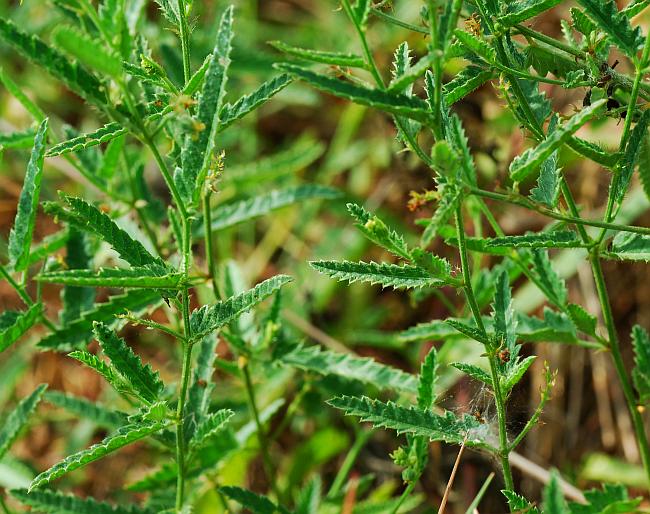Tragia ramosa Torr.
Noseburn

Native
CC = 7
CW = 5
MOC = 9
© SRTurner
Tragia ramosa Torr.Noseburn | |
 |
Native CC = 7 CW = 5 MOC = 9 |
© SRTurner |
|
Family - Euphorbiaceae Habit - Perennial forb, monoecious, with a woody vertical rootstock, with clear sap, variously pubescent with shorter, unbranched, nonglandular hairs and at least some longer, needlelike, stinging hairs. Stems - Loosely ascending or spreading, to 30 cm, pubescent with moderate to dense, short, mostly curved, softer, nonstinging hairs and moderate longer, stiff, spreading, stinging hairs.
Leaves - Alternate, simple, usually short-petiolate. Stipules 1-4 mm long. Leaf blades 1-4 cm long, linear to narrowly oblong or lanceolate-triangular, rounded to truncate at the base, rounded or more commonly angled to a sharply pointed tip, the margins sharply toothed, pinnately veined, the surfaces pubescent with sparse to moderate nonstinging hairs and usually moderate stinging hairs.
Inflorescences - Lateral opposite the leaves, slender racemes with 1 pistillate flower at the base below 2-10 staminate nodes toward the tip, each flower with a short, slender bract, this 1-2 mm long. Flower stalks 0.7-2.0 mm long.
Flowers - Staminate flowers with the bract 1-2 mm long; the flower stalk 0.7-2.0 mm long; the calyx 3-or 4-lobed, 1.0-2.2 mm long; the stamens 3 or 4. Pistillate flowers with the bract 1.5- 2.0 mm long; the flower stalk 1.0-1.5 mm long at flowering, elongating to 2.0-2.5 mm long at fruiting; the calyx 6-lobed, 0.8-2.5 mm long at flowering, shorter than the pistil, enlarging to 1.5-3.0 mm long at fruiting; the styles fused toward the base less than 1/3 of their length, the stigmas nearly smooth. Corollas absent. Ovary usually with 3 locules and 1 ovule per locule, the 3 styles fused toward the base, not further lobed or branched.
Fruits - Capsules, 3-lobed, 3-4 mm long, 6-8 mm in diameter, moderately pubescent with mostly stinging hairs, violently dehiscent. Seeds nearly spherical, 2.5-3.5 mm long, smooth, yellowish brown to brown, sometimes mottled.
Flowering - June - September. Habitat - Glades, dry pastures, roadsides, ditches. Origin - Native to the U.S. Lookalikes - T. betonicifolia, which is much more common in Missouri. Other info. - This interesting species with inconspicuous flowers is uncommon in Missouri, found mostly in the southwest corner of the state. In fact, Missouri populations represent the far northeastern extent of the plant's natural range, which otherwise extends westward from Missouri as far as California. The plant's appearance is similar to the more common T. betonicifolia, but the leaves are typically smaller, narrower, and narrowly oblong rather than lanceolate. More reliable characters for differentiation are found in the pistillate flowers, which have calyx lobes shorter than the pistil, styles fused less than 1/3 of their length, and nearly smooth stigmas. Beware: most parts of the plant bear stinging hairs (visible on some of the images above), which can make close examination a painful experience. Photographs taken near the Blue River and Hwy 7, Johnston County, OK, 7-27-2016 (SRTurner). |